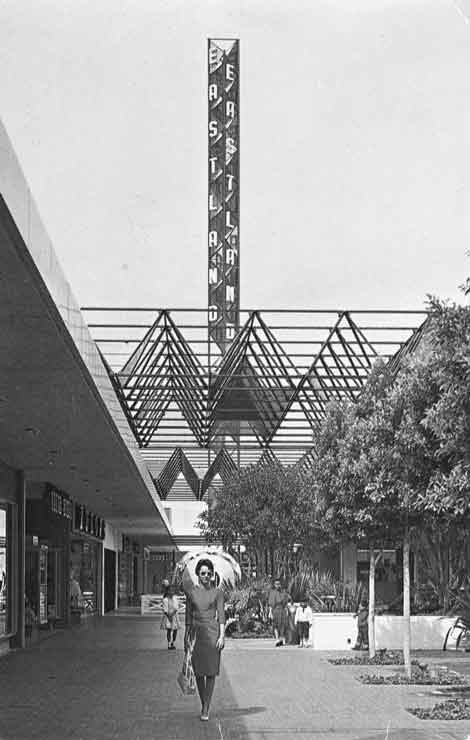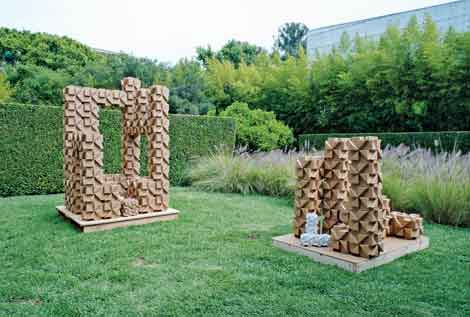LA’s rise as a major architectural center, chronicled by the Getty Research Institute in Pacific Standard Time’s ongoing and extensive set of shows, is difficult to reconstruct despite the copious evidence. The architectural history of Los Angeles is multifaceted and heterogeneous; each of the historical strands that make up that complexity forms a complicated set of relationships with a larger, equally fragmented and increasingly globalized postmodern meta-history.
For example, the PST exhibitions carefully explore the relationship of a built Los Angeles inextricably linked to the explosion in the 1960s and ’70s of interest in “vernacular” architecture and the “planning” of sub- and exurban sprawl. These trends have been analyzed and valorized by many, including the historian Reyner Banham and the postmodern theorists, teachers, and designers Robert Venturi and Denise Scott Brown, aided and abetted by colleagues and students, LA artist Ed Ruscha and others, including the pioneer Esther McCoy. Yet this is hardly the only postmodernism to which LA can be linked. David Gebhard and Robert Winter’s seminal Architectural Guidebook to Los Angeles, for example, points to the relentlessly historicizing vision of the original Getty Villa, a flamboyant yet archeologically precise replica built in 1974 by Langdon and Wilson, while Fredric Jameson locates the architectural ground zero of his postmodern “cultural logic of late capitalism” in John Portman’s Bonaventure Hotel (1974–1976).

Eastland Shopping Center; woman in red dress, about 1957, A. C. Martin and Associates and David M. Mills, Chris Nichols Collection
Given the considerable possible pitfalls, the GRI has done an admirable job in collecting and collating an enormous amount of material. The series of exhibitions that have been mounted at nine different venues from Pomona to Santa Barbara lay a solid foundation for an ongoing historical, academic, political and social conversation about the development of a truly region-specific architecture in post-modernity. Angelenos—as policy-makers, citizens, critics and historians—can come to a better understanding of where our city and region have been, where they are now, and where we might want to take them in the future—in so far as we can influence a living and evolving built environment that will never be under anyone’s complete control.
Any attempt to assess the GRI’s architectural initiative must begin with the Getty’s own exhibition “Overdrive,” which provided the hard-core historical, demographic, economic and developmental background upon which LA’s history of a built environment is necessarily inscribed, like the massive grid of freeways that increasingly crisscrossed the landscape during the 1950s and ’60s. As an exhibition, “Overdrive” was dense, exhaustive, and exhausting—absolutely a multiple-visit show. Its thematic organization was diffuse; but the choice of topics and the amazing objects and images assembled by the curatorial staff made the visitor’s struggle with the exhibition’s massiveness completely worthwhile.
As an icon of LA’s fabled mobility, the 1970 photograph of Joan Didion with her Corvette Stingray by Julian Wasser, here mobilized in the service of a disruptive feminism, was alone worth the price of a parking pass.
The catalog, edited by Wim De Wit and Christopher James Alexander, was itself a finely tuned vehicle for navigating the ecologically diverse terrain laid out in the show. I was especially intrigued by Becky Nicolaides and Dana Cuff’s essays in the section “Developing Communities,” although virtually every essay provided essential information as well as contributions to what eventually amounted to a fine mini-archive of architectural, historical and perfectly pitched contextual images. Overdrive: L.A. Constructs the Future, 1940–1990 will remain an essential basic text for a long time to come.

Jef Raskin, Bloxes, 1970–71, rebuilt 2013, installation view from “Everything Loose Will Land,” ©Estate of Jef Raskin, Courtesy of Aviva Raskin, Photo by Mark Escribano
On a quite different scale was a small but wonderful exhibition curated by UCLA’s Sylvia Lavin in the MAK Center space at the Schindler House in West Hollywood. “Everything Loose Will Land” was a brilliant look at a particular set of interrelationships between art and architecture, what the curator dubs a kind of “de-architecturization” of architecture during a particularly freewheeling decade—one that saw the publication in Design Quarterly of Ed Ruscha’s little known follow-up to his seminal deadpan photographic series (beginning with 1962’s “Twenty Six Gasoline Stations”), the thoroughly tongue-in-cheek Five 1965 Girlfriends. Here, one might fruitfully compare Erika Skoda leaning negligently on her Porsche to the much more forced informality of Ms. Didion’s self-presentation with her Stingray.
“Everything Loose Will Land” worked via a temporal and intellectual frame that was carefully calculated to maximize our appreciation for the interpenetrating, multivalent, cross-fertilizing ways in which a surprisingly semi-permeable “architecture” has interacted across numerous less-than-rigid disciplinary boundaries to constitute an environment at once thought, imagined, drawn, modeled, built and lived. The catalog is equally sharp; especially appreciated is the section titled “Works on Paper,” which re-publishes in semi-facsimile a number of important primary sources in a way that facilitates our visual appreciation of the material under consideration.
Finally, a word about LACMA’s “The Presence of the Past: Peter Zumthor Reconsiders LACMA.” This galvanizing exhibit focused on the solution proposed by Pritzker Prize–winning Swiss architect Peter Zumthor to resolve the ongoing problem of LACMA’s diffuse and difficult-to-navigate campus. Beginning with a collection of bones from the Page Museum’s La Brea Tar Pits collection balanced against Charles R. Knight’s magnificent 1925 mural recreation of tar-pit life (and death) during the Pleistocene, Zumthor walks us carefully through the early history of the site and then through every phase—built, planned, projected or imagined—of the ongoing build-out of the campus, up to his own controversial attempt to link museum and tar pits into a single spectacularly undulating whole.
However, this small but trenchant exhibition could have profited enormously from an accompanying publication. Losing sight of all this material after the close of the show is a real loss to the continuing conversation over LACMA’s past and future. Indeed, this show—as well as the beautiful installation of material related to Frank Gehry’s National Art Museum of China competition entry, appended to the “New Sculpturalism” exhibition at the Geffen Contemporary (reviewed in our last issue)—suggests that in a moment of profound self-reflection, the GRI might consider a show or (better) a series of shows on the history of museums in general (not just the art museum) as iconic instances of the preservation and presentation of our collective cultural memory.


